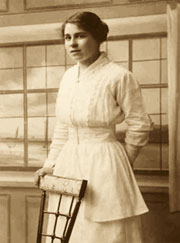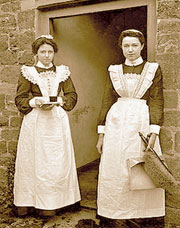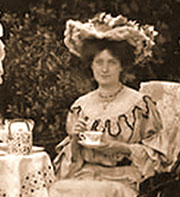Read about Bob Massie's biography of the great Russian Empress and one of my favorite historical figures.
Emergency Service
Serving Large Numbers Where Time is a Considerable Factor, as in Schools, Institutions, Church Suppers, Etc., Etc.
TABLES
For the kind of service indicated in the foregoing heading guests can be waited upon more advantageously when seated at one or two long tables than at small tables.A silence cloth is not often available, and thus the damask is draped over the bare table. As a suggestion that ought to meet favor, when a new outfit is under consideration, we would call attention to the possibilities of small rectangular tables (of a size suitable for four or six persons) finished with glass tops over an inexpensive board upon which a figured cretonne is spread. Of course the cretonne should be of delicate tints; perhaps the most satisfactory are light green, shading to peacock colors, with perhaps a little gray or coachman's drab. These tables are commended, because, once installed, there is absolutely no expense for renewal or laundry save for napkins. The glass top should be made of a size to come flush, on all sides, with the edge of the cloth-covered board that forms the foundation for the glass. In serving large numbers these tables may be set close together, to form one or two large tables.
LAYING THE TABLE
The "covers" should be laid in the same manner as previously indicated this pages. If it be necessary to have the table laid an hour or two in advance, the individual butter dishes and the glasses for water, for obvious reasons, should be set upside down.
TYPICAL MENU FOR EMERGENCY SERVICE
(One waitress for each ten or twelve guests)
Course I.
Consomme with Macaroni Rings. Bread Sticks. Olives. Radishes.
Course II.
Roast Lamb, Mint Sauce, Brown Sauce. Potato Browned with the Meat. Marshed Turnips. Lettuce, French Dressing.
Course III.
Cottage Pudding, Strawberry Sauce. Coffee.
THE COVER
Each cover calls for soup plate in center of cover, soup spoon, knife (for second course) at right of cover, glass for water at tip of knife blade, small butter-dish at left of glass; fork for dessert, fork for second course and napkin at left of cover. The fork for dessert may be omitted from the cover. It simplies matters, when crumbing the table, if the fork for dessert be put in place when needed.vWhen the time for serving the meal arrives, the glasses should be filled with water, butter set on the individual plates, a tablespoonful of macaroni rings be disposed in each soup plate and over it about threefourths a cup of soup be poured. The soup should be poured from an agate pitcher. Three bread sticks should also be disposed above each plate; these things being done, dinner should be announced.
SERVING THE SOUP AND RELISHES
If preferred and plates are available, a dinner plate may be set beneath the soup plate and after the eating of the soup be removed with it. To insure hotter soup this course may not be brought to the table until the guests are seated.Then the waitress brings in filled soup plates on service plates, one in each hand, and sets them down from the right; or puts one at the left and turns and sets the other to the right without going around the chair. This use of the service plate is to be commended when two soup plates are brought in at the same time; by this means the hand does not come in contact with the edge of the soup plate, a point to be desired when one considers how difficult it is to carry even one plate on a level. And in this the waitress carries two plates.
The olives and radishes add to the attractiveness of the table and, chilled and crisp, may be set in place at regular intervals down the center of the table just before the water is poured. Guests may help themselves to these relishes and pass them on a tray to the left of each guest, and then return the dishes to their places on the table.The soup plates, or soup and service plates are removed, one in each hand.
SERVING THE SECOND COURSE
Passing out with two soup plates, the maid returns with two plates, one in each hand, holding a thin slice or slices of meat and a browned potato; these are set down before the guests whose soup plates have been removed.This is repeated untill all are served, then mint and brown sauce are passed on a tray to the left of twenty or twenty-four guests and the waitress, relieved from this duty, follows with the turnip, on a tray or on a folded napkin on the hand, and presents it to the left of each guest. The plates of dressed salad are brought in, one in each hand, and set down at the upper right hand of each cover. A salad served with a roast is eaten with the fork provided for the roast. The second course having been served, opportunity is offered to replenish supplies of water, bread, butter, or any item included in the second course. When the second course is finished, the salad plate and the course plate, one in each hand, are removed in order; the dishes or relishes and the salt and pepper bottles are removed on trays, and the table is freed of crumbs.
SERVING THE SWEET COURSE
In crumbling the table note that each cover is supplied with a dessert fork, and, when crumbling is finished, if through any inadvertence forks are needed, set them in place, using tray, even if it be for a single fork. Bring in the pudding, dressed with sauce, a plate in each hand. After all have been served, additional sauce may be passed on a tray to the left of each guest. Bring coffee spoons on a tray and set one at the right of each guest; bring in the cups of coffee on a tray, and set them at the right, between the dessert plate and the coffee spoon. Pass sugar and cream on a tray to the left of each guest. Fill the glasses with water.
VARIATIONS OF THIS SERVICE
A fruit or oyster cocktail sometimes takes the place of the soup or is served before it. This should be in place when dinner is announced.If served before a soup, remove the plates holding the cocktail glasses, one in each hand, and return with soup plates on service plates, one in each hand; repeat untill all are served.
SALAD AS A SEPARATE COURSE
Often the salad, as lettuce, celery, endive, etc., is not served with the roast, but as a course by itself, with cheese, pulled bread or toasted crackers. In this case bring in a plate of salad in each hand and repeat untill all are served. Then bring in the cheese and crackers on a tray and pass them to the left of each guest.If a hot cheese dish, as a souffle, or cheese balls cooked or disposed for service on one dish be passed, the portion taken should be upon the salad plate.Hot cheese in individual dishes should be brought in on small plates and the salad on separate plates.It is immaterial whether the cheese or the salad be first served.The salad fork suffices for the course.
CHOICE OF DESSERTS
When a choice of desserts, as pudding, or pie, a hot or a cold sweet is provided, the waitress names the two desserts, and, being informed as the articles desired by two guests, returns with a plate in each hand, and continues in the same manner until all are served. If the table be laid with forks for the dessert course and a spoon is required, the two plates with the silver needed may be brought in on a trayl set the silver in place, then set down the plate of food. Proceed in the same manner, if any guest wishes both articles provided for the sweet course.
SERVING TYPICAL MENU WITH ONE WAITRESS FOR EACH FIFTEEN OR TWENTY GUESTS
The details of "the cover" are the same as in the first case, but relishes and soup should be on the table when dinner is announced; the service plate should be discarded and the soup plates supplied with soup from the pitcher. Guests will help themselves to the relishes and pass them to their neighbors. To clear the table, remove the soup spoons to a tray and take all from the rooms at once.Returning, set the plates for five covers, one above the other on the tray; take these from the room and return for five more plates; continue untill all are removed.Then bring in two plates prepared for the second course, with meat, potato and turnip, and set them down from the right; bring in the two sauces on a tray, take them from the tray and set down at the left of the first served; this individual should help himself and pass on the sauces; return for two plates of meat, etc., untill all are served; then bring in three plates of dressed salad on a tray, and, having set them down at the upper right hand of the several covers, bring in other plates until all are served. Clear the dishes of this course from the table in the same manner as in the first course. The silver on a tray, then the salad plates, five at a time, then the dinner plates, five at a time. Bring in the sweet course on a tray, three plates at a time. In clearing the table, first remove the silver on a tray, then the plates, five at a time. This number of plates to be removed at a time is suggested, because with that number the tray does not look overloaded, and that number can be carried with little risk of accident. If the ware be thin, six, or even seven, plates could be carried with ease. But in no case should the tray be, or appear, heavy.
In serving after dinner coffee, the spoons, brought in on a tray, should be set down at the right; four or five cups and saucers may be brought in on a tray, and set down at five different covers, between the spoon and the plate, holding the sweet course. Continue until all are supplied with cups. Now bring in the sugar and cream and set them down at the left of the first one to be served. Return for the coffee pot, wich should be brought in on a tray and set down on the serving table at the side of the room. Take the coffee pot from the tray and fill the cups. The sugar and cream may be passed by the guests.




